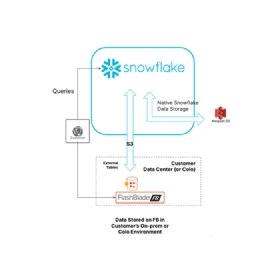
Getty Images
Pure Storage, Snowflake partner on analyzing local data
Snowflake and Pure Storage have partnered to bring data analytics capabilities to FlashBlade storage without the need to move the data to the cloud.
Pure Storage and Snowflake Inc. are now partnering to bring Snowflake's data analytics capabilities to data on Pure's on-premises hardware.
The partnership, which will be available for public preview later this year, will bring Snowflake Data Cloud's data analytics capabilities to local data stored on Pure Storage FlashBlade. This will enable customers to analyze large data sets stored on the unified file and object storage array without having to make copies of the data or move the data to the cloud, which comes with its own set of issues, according to Robert Lee, CTO at Pure Storage.
"Moving [data] into the cloud and migrating it natively is challenging either because of requirements to adhere to, or just the ergonomics and the complexity involved in moving the data," Lee said.
Customers need a level of control over the data, such as for compliance reasons where it needs to be in a certain place, and the size of the data makes moving it to the cloud for analytics too challenging, Lee said.
Combined benefits
Pure Storage FlashBlade is the company's all-flash file and object array. FlashBlade was built with a focus on high-performance analytics such as artificial intelligence (AI) workloads, Lee said. The Snowflake Data Cloud was built for similar workloads in the cloud.
The new partnership will bring the storage and analytics capabilities together by bringing Snowflake's capabilities to FlashBlade using Amazon S3.
"The analytics, the compute engine of the data warehouse would still be running in Snowflake in the cloud. But it would be accessing data on-prem, to run those queries and answer those questions," Lee said.
To make the partnership work, Snowflake needed to make changes around network security and integration to point its data warehouse capabilities at on-premises storage.

FlashBlade was at the forefront of high-performance object storage when it launched in 2016, according to Scott Sinclair, a senior analyst at Enterprise Strategy Group, a division of TechTarget. FlashBlade formed a similar partnership in May 2020 with Nvidia for machine learning, AI and big data analytics. The architecture of FlashBlade aligns with analytic workloads such as Snowflake's, he said.
"If you run the type of data platform that Snowflake has, where it leverages that type of [all-flash] back-end storage, then [FlashBlade] makes tremendous sense," Sinclair said.
Large amounts of data are hard to move, and storage can get expensive in the cloud, Sinclair said. The partnership provides Pure customers access to analytics capabilities without having to migrate data to the cloud.
Push toward hybrid workloads
Last week, Dell Technologies unveiled a similar partnership with Snowflake at its annual customer conference, which suggests a demand for on-premises offerings from SaaS providers.
"We've been working with the Snowflake team on developing this solution for almost 12 months now," Lee said, noting the partnership was driven by a handful of large enterprises with complex data footprints. "The two teams saw a potential for a one-plus-one equals three for the customers."
Sinclair echoed the point that the partnership was a win-win for the vendors and customers alike, especially given that in the past few years, workloads conducted in the public cloud have grown.
"Organizations have gone through learning experiences in terms of what types of workloads are ideal for public cloud environments and what types are not," Sinclair said. "Some companies are saying, 'Look there is a different approach.'"
He did note that the partnership is still new but added that both use S3 technology, and after a year of working together Pure and Snowflake are most likely close to working any bugs out.






